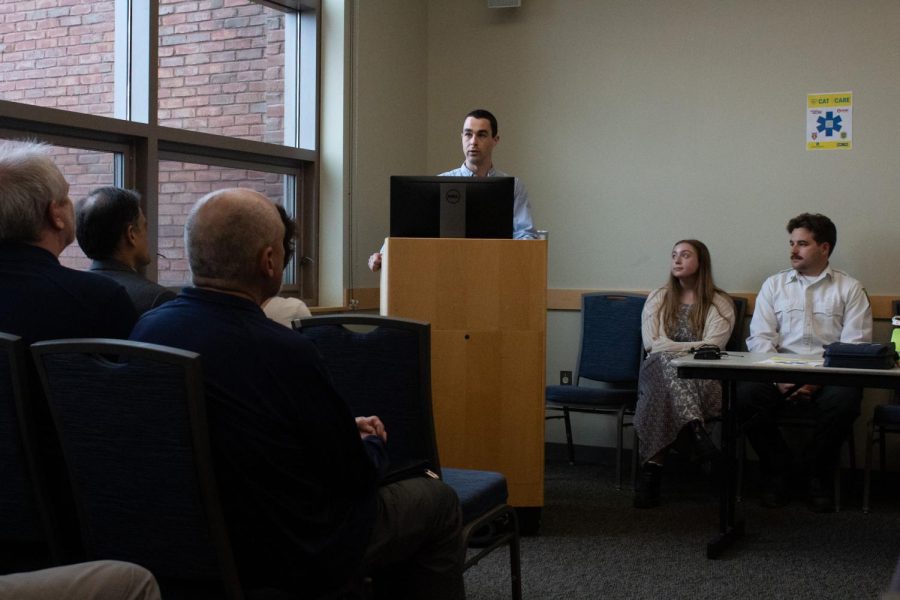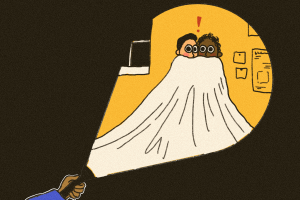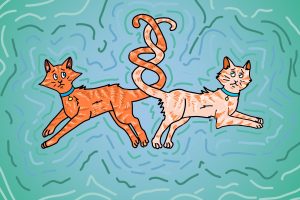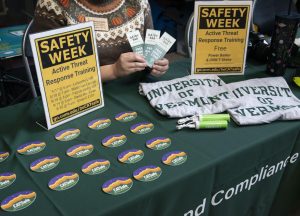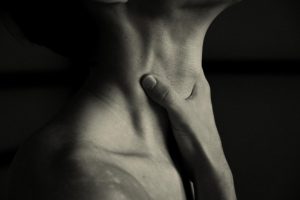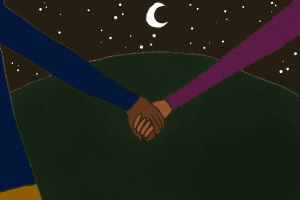Narcan, bleeding kits to be added to AED stations under new CAT ECare program
Senior Eli Racusin discusses his experiences and contributions to the Cat ECare program during a kickoff event in the Davis Center April 17.
April 25, 2023
Updated and new emergency response stations and training classes for UVM affiliates will be implemented starting this summer, according to the CAT ECare webpage.
The initiative aims to add to UVM’s current 38 automated external defibrillator stations with Narcan and bleeding control kits as well as installing new stations with these items included. It will also offer training classes to prepare participants on how to perform CPR and use these safety items, according to the webpage.
“Last spring semester, [Emergency Manager John Marcus], public health interns and I [started] working together about the logistics and the corresponding training program,” said Patrick Malone, program director of the Initiative for Rural Emergency Medical Services.
During these meetings, the group decided to include Stop The Bleed kits and Narcan in both the new and updated stations in order to address potential shootings and opioid overdoses, Malone said.
Narcan, or naloxone, is a life-saving medication that can reverse an opioid overdose that comes as either an injection or nasal spray, according to the Centers for Disease Control and Prevention.
The inclusion of Narcan in the CAT ECare kits will address a trend of an increasing number of opioid deaths in Vermont, Malone said.
Bleeding control kits are stocked with tourniquets and gauze and are intended specifically for severe, life-threatening bleeding, according to the American Red Cross.
“The kits we’re making […] are going to be installed in buildings by the end of the semester,” Malone said. “So that’s some number up to 50. And there’s something like 38 on campus already. So I would say we’re at least going to double the number [and] get closer to 100.”
Prior to CAT ECare, various University departments and buildings were in charge of adding AEDs, Malone said. Now, with the University taking over this responsibility, it will be under the scope of the Office of Emergency Management who will implement uniform AEDs, he said.
“We’re focusing on academic buildings, because that’s where the public is,” Malone said. “And there’s more people moving around those. At least from the cardiac care component of this, a dorm with a couple hundred students in it is probably a lower risk environment than the Williams Building where there’s faculty, staff and visitors.”
Eli Racusin, a senior who contributed to the project through a public health capstone internship, said the updated stations will create a greater level of response and campus-wide preparedness in the face of a health emergency.
“Every day in the U.S., there’s mass shootings, and every day in Vermont people die from opioid overdoses,” Racusin said. “And so all these tools just form a more cohesive safety net to be able to really just bring the safest atmosphere possible [to UVM].”
Racusin, who grew up in a rural town with little access to medical resources, believes the program will have rippling effects off-campus as well, he said.
By providing training to students to take their knowledge home to their underserved hometowns, the life-saving effects would become exponential, Racusin said.
As of right now, the goals of the program are to provide as many classes as possible so that any UVM affiliate who wants to get trained can, and to ensure the program can function at a capacity where no one has to be turned away, Racusin said.
While the budget is still being finalized, the training will charge a nominal fee to cover instructors and supplies, Marcus said. Undergraduate students can also earn academic credit while training to become instructors and receive payment to teach classes.
The current uptick in dormitory property offenses has been a consideration for CAT ECare plans concerning where stations are installed, though the goal is to eventually have Narcan and bleeding kits available in all residential buildings, Racusin said.
“So [we’re] just trying to figure out how we can make sure that everyone is being covered, but also that we’re not losing hundreds of dollars of expensive equipment having to constantly restock,” Racusin said.
Racusin said that ideally, every floor of every building—academic, residential and otherwise—will be equipped with ECare stations.
“It’s really good to see that the University is taking some steps to educate people more on how to help out your fellow community members,” said first-year Sarah Kelly, secretary of the Disabled Student’s Union.
Kelly said they would like to see the University implement training for disability-related emergencies in ECare classes, including faintings and seizures.
“I haven’t really seen [such classes] available […] so it’s good that we’re moving towards having more access to that sort of thing,” they said.
Kelly also said they believe it would be beneficial for the University to heavily encourage taking the classes through student outreach because many students are on their own for the first time at college. It is important to have that kind of resource available when issues arise, they said.
“I think Narcan is especially helpful,” Kelly said. “Even though we’d like for [overdoses] not to happen, it is a reality that it does happen. And so you need to have the tools [to be] able to deal with it when it does.”
Junior Katie Marshall said she would take the training classes offered under this program, and that the program is beneficial for UVM.
“When it comes to healthcare, particularly emergency healthcare, you can never be over-informed,” Marshall said. “UVM needs to ensure that trainings are ongoing, information is freely available and that they monitor the usage of the program and equipment to tackle the base problems to the fullest extent they can.”
Marshall also said that in the absence of legislative action to prevent such emergencies, it is particularly important for people to be prepared.
“I truly believe in the fact that training programs like this have the ability to reach a ton of people and kind of create a cascade effect,” Racusin said. “There’s never a more critical time to be able to help yourself and help your neighbor, so I think this program kind of embodies that.”


